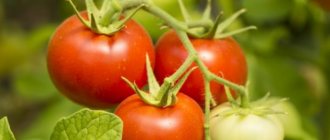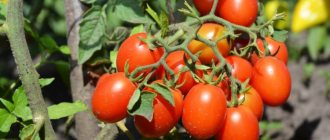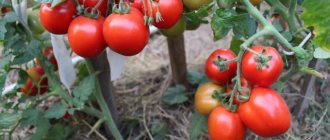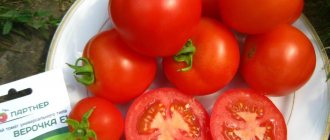Description and characteristics of the variety
The variety was bred in Moscow by breeders who were part of the Aelita team. Over the course of 2 years, the tomatoes underwent several inspections, after which in 1999 it was officially added to the register in 1999.
Tomato Wild Rose. Photo
The Wild Rose tomato is intended for cultivation in garden plots; specific and recommended growing areas have not been identified. Recommendations were given according to which tomatoes can be grown in open ground in the southern regions, and in film greenhouses without heating in the northern regions.
The Wild Rose tomato variety can reach any height ; the top of the bush is not limited by flower brushes. It can reach at least 2 m in height. All bushes with tomatoes should be tied up and formative pruning should be carried out. The leaves are large and green. There are a large number of leaves on the bushes.
The first inflorescence is usually formed after the 9th leaf appears. All subsequent inflorescences are formed after 2-3.
The fruits ripen early; if the bushes grow in a good climate and are regularly cared for, the harvest is obtained within 3 months after the sprouts appear. The shape of the tomatoes is round, compressed at the top and bottom, and the fruits themselves are smooth. The color of ripe berries is pink. As a rule, ripe tomatoes are large, weigh about 300 - 350 g and contain at least 4 nests with seeds.
The tomato pulp is fleshy and the skin is thin. Wild rose is often used in salads because it has a sweet and sour taste. However, it can get worse if the tomatoes are grown in an area with insufficient light.
However, the yield of the variety is not so high: almost 6 kg of tomatoes can be harvested from 1 m2. At the same time, it can withstand high temperatures, which allows it to be grown in southern cities in open ground. Tomatoes of this variety can grow on any type of soil and do not suffer from tobacco mosaic.
Tomatoes of the Wild Rose variety do not crack during the ripening process, but they do not withstand long transportation, since they do not last long when fresh. If you need to preserve tomatoes for 7–14 days, you should pick them slightly unripe.
The table shows the main characteristics of the variety that are of interest to gardeners.
| Purpose | For fresh consumption, it is not suitable for preservation due to its large size. |
| Unripe fruit color | Green with dark spots |
| Color of ripe tomatoes | Pink |
| Pulp | Meaty and a little sugary |
| Number of tomatoes in 1 brush | 3-4 pcs. |
| Stepson and garter | Performing these steps is important when growing this variety. |
| Virus resistance | Does not get sick with tobacco mosaic virus |
Reviews about the variety
According to professional gardeners, those who have at least once planted Wild Rose tomatoes will never give up this variety of vegetable crop.
- Vladimir Stepanovich. Crimea. Wild rose tomatoes have been grown for 6 years. This variety of tomatoes has excellent taste, which is why our family loves it so much. Our climate is steppe and arid, but plants easily tolerate lack of moisture and heat, and vegetables quickly gain weight and become sweetish. Caring for the crop is simple and does not take much time and effort. The only inconvenience is that the bushes produce multiple shoots that need to be cut off periodically.
- Ekaterina Lvovna. Moscow region. Pink tomatoes have always been my weakness. But I was able to grow a full-fledged harvest of vegetables only after planting Wild Rose tomatoes. The culture is completely undemanding to weather conditions and easily tolerates the rainy season and temperature changes. The bushes grow tall, requiring additional care and pinching. But even such measures cannot interfere with obtaining a harvest of vegetables with an excellent, sweet taste and tomato aroma.
Previous
TomatoesTomato variety Auria: yield and description
Next
TomatoesTomatoes Honey Spas: yield and characteristics of the variety
Advantages and disadvantages of the variety
The Wild Rose tomato has both advantages and disadvantages.
Thus, gardeners note the following advantages of these tomatoes:
- Pleasant taste of fruits;
- Large weight of ripe berries (the largest can weigh about 600 g);
- Resistance to high temperatures;
- Ability to adapt to any type of soil;
- Resistance to diseases that other tomato varieties are susceptible to.
During the growing process, the following shortcomings were identified:
- Low yield;
- The quality and quantity of the harvest depends on climatic conditions;
- Each bush must be pruned and shaped;
- The bushes must grow over a large area, otherwise the plants may not have enough nutrients.
Despite the fact that the variety has both pros and cons, they cannot be considered unambiguous. For some gardeners, what is considered a disadvantage of a variety can become its advantage.
For example, in hot climates, a significant part of tomato varieties are unable to grow: they shed flowers with ovaries, and the fruits simply do not appear. Therefore, gardeners from the southern regions of Russia often grow this variety in their own gardens.
Planting methods and timing
Wild rose tomato can grow in any type of soil, including soil with a high salt content. It was found that higher quality crops grow in places where pumpkins, cucumbers or cabbage previously grew.
Like many other tomatoes, Wild Rose should be grown from seedlings. However, in the south this is not necessary, since the climate allows fruits to be grown directly in greenhouses. In the southern regions of the country, the fruits will ripen in 3.5 months. However, experts note that there is no point in such planting, since one of the advantages of Wild Rose - early ripening - will not work in this case.
The timing of planting seedlings is early March. As a soil for planting, you can use a special mixture for tomatoes. It is better to buy seeds for planting and soil in specialized stores, since the quality of goods here is higher than in large chain supermarkets.
You can also prepare the soil yourself by mixing turf, garden soil and humus. Before planting seeds in the soil, it should be calcined and watered with a solution of copper sulfate or potassium permanganate. The seeds need to be buried a little in the ground and covered with a little peat.
The trays with seedlings should be covered with a transparent film or lid and left in a warm place. The film can be removed when small sprouts appear. Then it is recommended to move the seedlings to a well-lit place. We must not forget about such a procedure as diving. It involves planting bushes in separate pots. All containers must be placed on a well-lit windowsill.
The quality of the harvest depends on the conditions in which the seedlings grew. At the initial stage of growth, it is necessary to monitor the room temperature. So, if it is too high, the sprouts will stretch. Watering future bushes should be moderate, at the root level. Do not pour water over greens. If you need to extend daylight hours, you can use special lamps.
The sprouts can be transplanted into the greenhouse in mid-May. The holes must be dug at a distance of at least 50 cm from each other. You need to add a little ash or mineral fertilizer to each hole.
After transplantation, you should install a plant support next to each seedling. After the bushes grow taller, you can add trellises - stronger support for bushes with fruits. To increase access to oxygen, you can trim the lower leaves on the bush. Seedlings must be planted according to a 70 x 70 cm pattern.
How to plant tomatoes
The yield of a vegetable crop depends on proper planting of seeds and further care of the seedlings.
The timing of sowing work is planned depending on the climatic conditions of the region and the method of growing the crop.
In order to correctly calculate the timing of planting in open ground, it is necessary to remember that the seedlings are transferred to a permanent place of growth at the age of 60 days.
If tomatoes are planned to be grown in greenhouse conditions, seedlings are transplanted into the soil at 1.5 months of age.
Preparing and sowing seeds
Before planting in the soil, the seed material undergoes additional processing.
- Planting material is carefully sorted, separating specimens with defects, damage and traces of rot.
- After selection, the seeds are placed in a solution of water and salt, where they are left for 20-25 minutes.
- All empty and non-viable specimens float to the surface, and seeds suitable for planting settle to the bottom of the container.
- Next, the seed is treated with an antibacterial solution and a growth stimulator.
- Prepared seeds are wrapped in a damp cloth and left in a warm place for 48 hours to germinate.
Plant seeds in pots or containers with fertile soil. To do this, garden soil is mixed with humus and minerals. The resulting disinfection mixture is heated in the oven at a temperature of at least 160 degrees.
The soil is poured into containers for growing seedlings, and grooves or planting holes are dug on top, no more than 1 centimeter deep.
Advice! In garden centers and flower shops you can purchase ready-made soil for growing seedlings. Also, tomato seeds take root well in peat pots or tablets.
Growing and picking seedlings
After careful preparation of the planting material and soil, the seeds are placed in planting holes at a distance of 1 centimeter from each other and lightly sprinkled with soil. After sowing is completed, the plantings are irrigated with a sprayer, covered with film and sent to a warm room.
To germinate seedlings, you will need a constant temperature of +26 degrees.
Containers with plantings are ventilated daily, removing the film cover.
After the sprouts appear, the covering film is removed and the plantings are transferred to a well-lit, warm place.
As soon as 2-3 tomato leaves appear on the plants, the seedlings are picked.
During this event, weak shoots are removed, and healthy, viable plants are placed in different pots, containers or plastic cups.
Further care of seedlings does not require additional effort and knowledge. Plants are watered in a timely manner and, if necessary, fed with minerals.
Important! The picking process helps the development of rhizomes and promotes the proper growth and development of vegetable crops
Growing technology
All actions that help to grow Wild Rose tomatoes should be performed carefully and carefully. If you make mistakes even in the simplest actions, you may not harvest the harvest or deteriorate its quality.
Watering
A distinctive feature of the Wild Rose tomato variety is that watering is very important for the bushes. The drip method of irrigating bushes is considered the most suitable, but if this is not possible, you can water it in a simple way.
It is recommended to water young bushes with tomatoes once a week, the amount of water is 1 liter per bush. Older plants should be watered on hot and dry days. If the weather is cloudy, watering can be done every 3 days.
Loosening and weeding
The Wild Rose tomato needs loosening and weeding. These actions are necessary to ensure that the plant receives enough air, which plays a big role in the growth and development of bushes. Loosening the soil is carried out along with its watering.
Weeds in the garden do not allow the bushes to develop, hide the plant from sunlight and can become a carrier of pests and diseases. For this reason, all weeds must be removed from the garden bed.
You can also mulch (cover) the bushes with straw. Straw is often used as a mulching material, which helps retain liquid in the beds. Straw-covered beds can be watered less frequently. However, in summer it is not recommended to resort to this procedure, since the frequency of watering in the summer should be increased.
Feeding
Tomatoes in a greenhouse can be fed with organic, mineral or complex fertilizers. Humus or compost are used as organic fertilizers. Mineral fertilizers include: superphosphate, urea, ammonium nitrate.
Complex fertilizers have also gained popularity among gardeners. Such products contain various mineral supplements that are beneficial for tomatoes and humus. Also, during the growing process, you can fertilize plants with products such as Epin, Zircon and Ovary. They belong to the means that stimulate the growth of roots and fruits.
Among the fertilizers intended for tomatoes, there are several of the highest quality products:
- Agricola is a mixture of powdered crystals. It must be dissolved in water and applied to the soil.
- Organic Mix is a complex of 17 components that are required by plants at all stages of growth and development. This type of feeding is distinguished by the fact that it dissolves slowly, enters the mail gradually and evenly saturates the roots with useful substances.
- Fertika Kristalon is a product that must be dissolved in water. It also contains all the components that members of the nightshade family need.
- Organic Mix Elixir is a natural fertilizer. The liquid fertilizer contains useful acids, amino acids and polysaccharides, which help increase productivity and accelerate plant growth.
Thinning
Since the leaves of the Wild Rose tomato are quite large, many leaves may appear on one bush. The emerging leaves may not allow sunlight to pass through, which is necessary for the fruits at the formation stage. In addition, dangerous pests may appear on the leaves. For this reason, tomatoes need thinning - it is necessary to remove the lowest leaves from the bushes.
Thinning bushes can also mean planting sprouts from a common box into separate boxes at the seedling stage. In a small box there will not be enough space for the bushes, so they should be divided into separate pots.
Bush formation
The formation of bushes includes several stages:
- Pruning - cutting off side shoots and shoots. It should be carried out no earlier than 14 days after the seedlings are transplanted to a permanent location. During these days the plant will take root and will easily tolerate this action. Such processes can be carried out either with scissors or with hands. The size of such stepsons should not exceed 7 cm.
- Pinching is an action aimed at limiting the growth of the main stem. The process is carried out early in the morning and involves removing the top of a soft shoot on a bush.
- Normalization of ovaries - cutting off too small or deformed fruit ovaries. This process is important because by examining the bush you can determine which ovaries will produce low-quality tomatoes.
- Tying - tying stems to posts or trellis. When giving the bushes additional support, you should not make hard knots so as not to damage the stem.
Pollination
Tomatoes can be pollinated either naturally or mechanically. To mechanically pollinate the bushes, you can knock on the branches. This will allow the pollen to land on the pistil. It is also important to monitor humidity: if the humidity is low, pollen will scatter and pollination will not occur.
Bush care
To get a good harvest, do not forget about the necessary care:
- Watering. The seedlings are not watered for the first seven days after planting, so that the seedlings adapt to new conditions, and this will also avoid rotting of the root system. The intensity and frequency of subsequent watering is determined by weather conditions when growing in open ground, and the condition of the soil when growing in a greenhouse;
- Feeding. During the season, 3-4 feedings are carried out. Gardeners who do not use chemicals can add “Gumat-super” in a ratio of 1/3 tsp. funds for 10 liters of water;
- Pinching and formation of bushes. Bushes are formed into one stem; formation into two is also allowed. To get an early harvest of large fruits, it is advisable to form them into one stem;
- Loosening and removal of weeds between rows. Regular weeding can be replaced by mulching the space between seedlings with straw or freshly cut grass.
Gardener's review of the variety:
Disease and pest control
The advantage of this variety is its resistance to many fungi and viral diseases that affect other tomato varieties. However, Wild Rose can suffer from some insect pests.
Septoria on tomatoes
In hot weather, spider mites can be found on bushes. Symptoms of the disease: the leaves wither, and on the bush itself, on the branches, a small cobweb forms. The method of controlling mites is the use of broad-spectrum insecticides.
Slugs damage leaves and gnaw fruits. The reason for their appearance is the predisposition of the soil. To get rid of them, you can mulch the soil with straw, sawdust or peat.
Garden ants can carry aphids, which also damage branches and leaves. Aphids can be identified by their limp leaves with black dots on the trunk and on the underside of the leaves. You can fight aphids using a solution of soap and potassium permanganate. It is also recommended to fumigate with sulfur. It is important to prevent substances from getting into the soil and, accordingly, into the fruits.
The cause of late blight is a fungal environment. You can tell that plants are affected by late blight by looking at blackened fruits and leaves. Having discovered infected seedlings, it is necessary to immediately pick the fruits and destroy the bushes.
Growing Tips
Before transplanting into the greenhouse, seedlings should not be watered for a week. Newly transplanted bushes are in new conditions, under stress, so they will not be able to absorb water. Stagnant water will harm the plants and they will rot.
Wild rose can be grown both in open ground and in greenhouses. However, in regions with short summers it should be kept under covering material. The cover must be removed gradually, the material should not be removed completely, in order to protect the plants from unexpected frosts.
The lower leaves of tomato bushes must be plucked off regularly, as moisture accumulates on them, which can cause them to rot. This step also helps ensure fresh air reaches the roots.
If tomatoes grow in greenhouses, they should be ventilated regularly. Fresh air has a positive effect on the growth of bushes and destroys pathogens of nightshade diseases.
It is recommended to feed tomatoes 3 times during the entire process of growth and development. At 1 time, fertilizing is applied in order to grow the bush; at 2 times, fertilizers help the plant to bloom and form ovaries. 3 times of fertilizing occur during fruit ripening.
At the same time, at the stage of bush growth, seedlings should not be overfed. If an excessive amount of fertilizer is applied, only stems and leaves will grow; ovaries with fruits may not form at all. Due to such early application of fertilizers, the bushes will not bear fruit.
You should not apply excess nitrogen fertilizers, since their excess will lead to the late appearance of ovaries and the fact that the fruits will be small in size.
To obtain a guaranteed high-quality harvest, you must:
- Feed tomatoes no more than 2-3 times a month.
Both complex fertilizers and nitrogen and potassium fertilizers are perfect for this. When purchasing, pay attention to the composition: it is worth purchasing fertilizers with the maximum content of phosphorus and potassium. Feeding is necessary at the stage of bush formation (discussed above), as well as at the stage of budding and formation of the vegetable. Do not forget to feed the seedlings a week after transplanting into the ground.
- Loosen the soil
An important and necessary procedure, especially after applying fertilizer. It helps not only to saturate the roots with air, but also ensures the best penetration of beneficial microelements and minerals into the bush. Loosening is also required after watering.
- Remove weeds
They can not only completely hide tomatoes from the sun, but also cause more serious and irreparable damage. Always keep your garden beds clean.
- Water
It seemed that it could be even simpler, but it is errors in watering that lead to the development of fungal diseases and death of the root system. Water strictly at the root, water should not get on the leaves. Ideal time: early morning before sunrise and late evening after sunset.
- Ventilate the greenhouse
It is extremely necessary to ventilate the greenhouse and monitor the temperature inside, because high humidity not only leads to the appearance of fungus, but can also completely destroy the bushes.
Harvest and storage
The ripening time of tomatoes depends on climatic conditions. So, if cultivation takes place in the southern regions of Russia, after 3 months you can harvest. If the climate is temperate, the fruits will fully ripen 100 - 105 days after the sprouts appear.
It is recommended to collect the fruits as soon as they turn completely red. If they were picked not fully ripe, they can be eaten at home, such as in salads.
The disadvantage is that the shelf life is too short, so it is recommended to use the fruits as quickly as possible. If you don't do this, the tomatoes will spoil very quickly.
When growing Wild Rose tomato, you should follow the recommendations for caring for the bushes. If you form seedlings in time, choose the highest quality ovaries, regularly water and feed, you can reap a large and tasty harvest.
Reviews from those who planted
Peter
My wife and I bought seeds at a fair two seasons ago. They didn’t pay much attention to the packaging and manufacturer. The seeds did not germinate. As it turned out, we bought the missing seeds, some of which were empty. And that summer, we bought the seeds from a trusted store and after 3 months the seeds produced the first tomatoes: tasty and juicy, just what you need for any dish.
Alexei
I have been growing tomatoes Rose for several years now. I like the variety, it’s not whimsical, you don’t have to fuss with it. The tomatoes always turned out juicy, and so many of them ripened that some of them were taken for sale while still unripe. Last season the weather was cool and I decided to grow tomatoes in a greenhouse. I did everything the same as always, but some of the seedlings fell ill with late blight. The neighbor then pointed out the mistake - I did not ventilate the greenhouse. The stuffiness ruined the entire harvest. So be careful.
How to sew jeans between your legs discreetly and accurately, by hand and by machine
Tomato Rose is a godsend for both novice and experienced gardeners. If all conditions are met, you can easily enjoy the results of your labor in just a few months: fragrant, juicy Rose tomatoes that will delight not only you, but the whole family.











